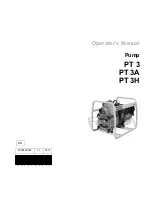
English
46
14.
Take care when stapling thin boards or the corners
of wood.
When stapling thin boards, the staples may pass
right through, as may also be the case when
stapling the corners of wood due to deviation of
the staples. In such cases, always make sure that
there is no one (and nobody’s hands or feet; etc.)
behind the thin board or next to the wood you
are going to staple.
15.
Simultaneous staping on both sides of the same
wall is dangerous.
Under no circumstances should stapling be
performed on both sides of a wall at the same time.
This would be very dangerous since the staples
might pass through the wall and thus cause injuries.
16.
Do not use the power tool on scaffoldings, ladders.
The power tool shall not be used for specific
application for example:
– when changing one driving location to another
involves the use of scafforldings, stairs, ladders
or ladder alike constructions, e.g. roof laths,
– closing boxes or crates,
– fitting transportation safety systems e.g. on
vehicles and wagons
17.
Do not disconnect the battery with your finger
on the trigger.
If you disconnect the battery with your finger on
the trigger, the next time the battery is connected,
there is a danger that the power tool will fire a
staple spontaneously, or operate incorrectly.
18.
Disconnect the battery and take out any staples
left in the magazine after use.
Disconnect tool from battery before doing tool
maintenance, cleaning a jammed fastener, leaving
work area, moving tool to another location, or
after use. It is very dangerous for a staple to be
fired by mistake.
19.
When removing a staple which has become stuck,
make sure to first of all disconnect the battery.
When removing a staple which has become stuck
in the staple outlet, first of all make sure to
disconnect the battery.
Accidental firing of the staple could be very
dangerous.
20.
To avoid hazards caused by falling staples, never
open the magazine with the device facing
downward while loading staples.
21.
When cleaning the power tool, do not use gasoline
or other inflammable liquids.
If vapour from an inflammable liquid gets into the
power tool, there is a danger that sparks produced
when stapling etc. may cause an explosion.
22.
Always assume that the tool contains fasteners.
Careless handling of the stapler can result in
unexpected firing of fasteners and personal injury.
23.
Do not point the tool towards yourself or anyone
nearby.
Unexpected triggering will discharge the fastener
causing an injury.
24.
Do not actuate the tool unless the tool is placed
firmly against the workpiece.
If the tool is not contact with the workpiece, the
fastener may be deflected away from your target.
25.
Disconnect the tool from the power source when
the fastener jams in the tool.
While removing a jammed fastener, the stapler
may be accidentally activated if it is plugged in.
26.
Use caution while removing a jammed fastener.
The mechanism may be under compression and
the fastener may be forcefully discharged while
attempting to free a jammed condition.
27.
Do not use this stapler for fastening electrical
cables.
It is not designed for electric cable installation and
may damage the insulation of electric cables
thereby causing electric shock or fire hazards.
28.
Always charge the battery at a temperature of 0
– 40°C.
A temperature of less than 0°C will result in over
charging which is dangerous. The battery cannot
be charged at a temperature greater than 40°C.
The most suitable temperature for charging is that
of 20 – 25°C.
29.
Do not use the charger continuously.
When one charging is completed, leave the charger
for about 15 minutes before the next charging of
battery.
30.
Do not allow foreign matter to enter the hole for
connecting the rechargeable battery.
31.
Never disassemble the rechargeable battery and
charger.
32.
Never short-circuit the rechargeable battery.
Short-circuiting the battery will cause a great
electric current and overheat. It results in burn or
damage to the battery.
33.
Do not dispose of the battery in fire.
If the battery burnt, it may explode.
34.
Do not insert object into the air ventilation slots
of the charger.
Inserting metal objects or inflammables into the
charger air ventilation slots will result in electrical
shock hazard or damaged charger.
35.
Bring the battery to the shop from which it was
purchased as soon as the post-charging battery
life becomes too short for practical use. Do not
dispose of the exhausted battery.
36.
Using an exhausted battery will damage the charger.
CAUTION ON LITHIUM-ION BATTERY
To extend the lifetime, the lithium-ion battery equips
with the protection function to stop the output.
In the cases of 1 to 3 described below, when using
this product, even if you are pulling the switch, the
motor may stop. This is not the trouble but the result
of protection function.
1.
When the battery power remaining runs out, the
motor stops.
In such case, charge it up immediately.
2.
If the tool is overloaded, the motor may stop. In
this case, release the switch of tool and eliminate
causes of overloading. After that, you can use it
again.
3.
If the battery is overheated under overload work,
the battery power may stop.
In this case, stop using the battery and let the
battery cool. After that, you can use it again.
Furthermore, please heed the following warning and
caution.
05Eng_N14DSL_NE
9/6/12, 11:10
46














































